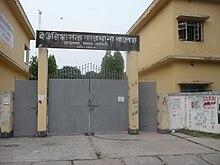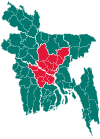Palash Upazila
Palash
পলাশ | |
|---|---|
Upazila | |
 Palash Location in Bangladesh | |
| Coordinates: 23°57′N 90°37.5′E / 23.950°N 90.6250°ECoordinates: 23°57′N 90°37.5′E / 23.950°N 90.6250°E | |
| Country | |
| Division | Dhaka Division |
| District | Narsingdi District |
| Thana | 1977 |
| Upazila | 1982 |
| Government | |
| • Upazila Chairman | Syed Javed Husayn |
| • MP (Narsingdi-2) | Anwarul Ashraf Khan |
| Area | |
| • Upazila | 94.43 km2 (36.46 sq mi) |
| • Metro | 19.21 km2 (7.42 sq mi) |
| Population (1991) | |
| • Upazila | 174,040 |
| • Density | 1,800/km2 (4,800/sq mi) |
| Time zone | UTC+6 (BST) |
| Website | palash |
Palash (Bengali: পলাশ, romanized: Polash) is an upazila of the Dhaka Division of Bangladesh. It is the smallest upazila (sub-district) of Narsingdi District.[1] Urban Palash is a part of Greater Dhaka; the conurbation surrounding the Bangladeshi capital city of Dhaka.
Geography[]
Palash is located at 23°57′00″N 90°37′30″E / 23.9500°N 90.6250°E. It has 31350 households and total area 94.43 km2. It borders Narsingdi Sadar and Shibpur on the east and Rupganj, Kaliganj and Kapasia on the west. The Shitalakshya, Haridoa and Old Brahmaputra rivers all flow through it, totalling 60km of river water within Palash's boundaries.[2]
History[]

During the Mughal period, the governor of Bengal granted Diwan Sharif ibn Munawwar Khan with the zamindari of Maheswardi Pargana. Diwan was the fifth descendant of Isa Khan, and married to Bibi Zaynab. The village of Sharifpur was named after him too. In 1714, Zaynab built a three-domed mosque in Sharifpur. The Brahmaputra River used to pass through modern-day Palash, and many sailboats would pass by Sharifpur. Due to this scenery, Sharifpur became known to locals as Parulia, from pal uriya meaning flying sails in the Bengali language.
During the British rule, the area suffered greatly from the 1897 earthquakes. The Muslim zamindars of Ghorasal were a notable landowning family, either founded by Ghulam Nabi or Abu Yusuf Lutful Kabir Fenu Miah. Fenu Miah's son was Manu Miah, and other notable members of the family include Najmul Hasan and Maulvi Abdul Qadir. The Hindu Sahas were another notable zamindar family, who were based in Danga. The final zamindar was Lakkhan Saha who had three sons; Nikunja Saha, Perimohan Saha and Bangku Saha. Following the Partition of India in 1947 and the Bangladesh Liberation War in 1971, Bangku and Nikunja respectively migrated to India. Perimohan inherited the land and was succeeded by his only son, Bauddha Narayana Saha who sold the estate to Ahammad Ali, a Bengali Muslim wakil. A thana (police station) was founded at Palash in 1977. In 1980, the Khilpara Darul Ulum Alim Madrasa was established through the initiative of Abdul Aziz and Shafaz Uddin.
Demographics[]

According to the official 1991 census, Palash had a population of 174,040. Males constitute 53.4% of the population, and females 46.6%. This Upazila's eighteen up population is 89627. Palash has an average literacy rate of 88.6% [3] By 2011 that population had grown to 212,612, consisting of 46,780 households.[4] Bengali Muslims form the majority, followed by Hindus, Buddhists and others.
Administration[]

Palash Upazila is divided into one municipality called Ghorasal in addition to four union parishads; Charsindur, Danga, Gazaria, and Jinardi. The union parishads are subdivided into 51 mauzas and 100 villages.[5]
Ghorasal Municipality is subdivided into 9 wards and 51 mahallas.[5]
Upazila chairmen[]

| Number | Name |
|---|---|
| 01 | Professor Fazlul Haq |
| 02 | Muhammad Faruqul Islam |
| 03 | Muhammad Faruqul Islam |
| 04 | Syed Javed Husayn |
| 05 | Syed Javed Husayn |
Economy and tourism[]
With access to the Shitalakshya River, Palash has three thermal power stations; one in Siddhirganj, one north of Ghorasal and one on the river bank.[6] There are four bazaars in Palash which are in Ghorasal, Palash Bazar, Charsindur and Danga. Other than those, there are 25 smaller haat bazaars across the upazila. Danga is famed for loom production, Charsindur for bananas, Jinardi for pineapples and Mausum for fruits in general.[7]
Palash is home to 92 eidgahs and 407 mosques, most notably the Miah Bari Mosque in Ghorasal and the Parulia Shahi Mosque complex which also contains the tombs of the former zamindar Diwan Sharif Khan and his wife Bibi Zaynab. The palaces in Danga of the former Saha family, the residence of RR Rubel Mullah and the Ghorasal zamindar estates are also popular tourist sites.
Infrastructure[]
The Palash Upazila also has 6 orphanages which take care of orphan children and educate them. These include:
- Islampara Hafizia Orphanage & Madrasa
- Qazirchar Qaumi Orphanage & Madrasa
- East Qazirchar Rah-e-Jannat Hafizia Orphanage & Madrasa
- Jaynagar Dar us-Salam Orphanage & Madrasa
- Hasanhata Nurani Hafizia Orphanage & Madrasa
- Galimpur Hafizia Orphanage & Madrasa
Education[]

There are four colleges in the upazila. They include .[8] Urea Sar Karkhana School & College is one of two higher secondary schools.[9]
According to Banglapedia, Charsindur High School, founded in 1919, Danga High School, Gayeshpur Padmalochan High School, Ghorashal High School (1945), Palash Thana High School, and Parulia High School (1933) are notable secondary schools.[1]
The madrasa education system includes two fazil madrasas.[10]
| Name | Headteacher/Principal |
|---|---|
| Danga Jamiah Ashraful Uloom Dakhil Madrasa | Muhammad Shamsul Haq |
| South Deora Deshgari Model Girls Dakhil Madrasa | Muhammad Abdul Karim Miah |
| Gazaria Madinatul Uloom Dakhil Madrasa | |
| Kajair Islamia Dakhil Madrasa | |
| Paikasha Dakhil Madrasa | |
| Khilpara Darul Uloom Alim Madrasa | Muhammad Ruhul Amin Khan |
| Palash Islamia Alim Madrasa | |
| Chalna Darul Ulum Fazil Degree Madrasa | Muhammad Ruhul Amin Patwari |
| Isakhali Fazil Degree Madrasa |
Notable people[]
- Ahmadul Kabir, politician and journalist
- Khayrul Kabir (1922-1997), founder of Jatiya Press Club, Pubali Jute Mills, Pakistan Arts Council and The Sangbad, former chairman of Janata Bank and Bangladesh Krishi Bank[11]
- Haripada Datta, novelist
- Saroj Kumar Nath Adhikari, educationist
See also[]
- Upazilas of Bangladesh
- Districts of Bangladesh
- Divisions of Bangladesh
| Wikimedia Commons has media related to Palash Upazila. |
References[]
- ^ a b Md. Iftekhar Uddin Bhuiyan (2012). "Palash Upazila". In Islam, Sirajul; Miah, Sajahan; Khanam, Mahfuza; Ahmed, Sabbir (eds.). Banglapedia: the National Encyclopedia of Bangladesh (Online ed.). Dhaka, Bangladesh: Banglapedia Trust, Asiatic Society of Bangladesh. ISBN 984-32-0576-6. OCLC 52727562. Retrieved 27 December 2021.
- ^ নদ-নদী [Rivers]. Polas Upazila (in Bengali).
- ^ "Population Census Wing, BBS". Archived from the original on 2005-03-27. Retrieved November 10, 2006.
- ^ "Census 2011" (PDF). Bangladesh. p. 27. Archived from the original (PDF) on May 8, 2016. Retrieved March 7, 2016.
- ^ a b "District Statistics 2011: Narsingdi" (PDF). Bangladesh Bureau of Statistics. Archived from the original (PDF) on 13 November 2014. Retrieved 14 July 2014.
- ^ Murshed, Muhammad Mahbub (2012). "Shitalakshya River". In Islam, Sirajul; Miah, Sajahan; Khanam, Mahfuza; Ahmed, Sabbir (eds.). Banglapedia: the National Encyclopedia of Bangladesh (Online ed.). Dhaka, Bangladesh: Banglapedia Trust, Asiatic Society of Bangladesh. ISBN 984-32-0576-6. OCLC 52727562. Retrieved 27 December 2021.
- ^ "ব্যবসা বাণিজ্য" [Business and Commerce]. Palasa Upajela (in Bengali).
- ^ "List of Colleges". Department of Secondary and Higher Education. Retrieved 6 September 2020.
- ^ "List of School and Colleges-2016" (PDF). Department of Secondary and Higher Education. Retrieved 6 September 2020.
- ^ "List of Institutions". Ministry of Education. Retrieved July 15, 2014.
- ^ "প্রখ্যাত ব্যক্তিত্ব" [Notable Personalities]. Palaash Upajila (in Bengali).
- Palash Upazila

